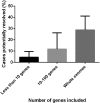A Systematic Review of Molecular Autopsy Studies in Sudden Infant Death Cases
- PMID: 30430032
- PMCID: PMC6234044
- DOI: 10.1055/s-0038-1668079
A Systematic Review of Molecular Autopsy Studies in Sudden Infant Death Cases
Abstract
Sudden unexpected death is an upsetting event, which can remain unexplained even after post-mortem investigation. Internationally, molecular autopsies have shown to resolve up to 44% of unexplained cases; however, it is currently unclear how many of these were infants. This systematic literature review showed that significantly fewer infant cases were resolved (median: 4%) compared with cohorts of 1 to 45 years old (median: 32%). Further, no study involving indigenous African participants has yet been published. Overall, molecular autopsies hold immense value to living family members and is motivation to explore new avenues in infant cohorts.
Keywords: medico-legal investigation; negative autopsy; sudden infant death syndrome.
Conflict of interest statement
Figures




Similar articles
-
A controlled study of the relationship between Bordetella pertussis infections and sudden unexpected deaths among German infants.Pediatrics. 2004 Jul;114(1):e9-15. doi: 10.1542/peds.114.1.e9. Pediatrics. 2004. PMID: 15231967
-
The role of molecular autopsy in unexplained sudden cardiac death.Curr Opin Cardiol. 2006 May;21(3):166-72. doi: 10.1097/01.hco.0000221576.33501.83. Curr Opin Cardiol. 2006. PMID: 16601452 Review.
-
Infection and sudden unexpected death in infancy: a systematic retrospective case review.Lancet. 2008 May 31;371(9627):1848-53. doi: 10.1016/S0140-6736(08)60798-9. Lancet. 2008. PMID: 18514728
-
Sudden cardiac death in young Danes.Dan Med J. 2012 Feb;59(2):B4403. Dan Med J. 2012. PMID: 22293060
-
Global trends in the extent of death scene investigation performed for sudden and unexpected death of infant (SUDI) cases: A systematic review.Forensic Sci Int. 2019 Aug;301:435-444. doi: 10.1016/j.forsciint.2019.06.013. Epub 2019 Jun 14. Forensic Sci Int. 2019. PMID: 31229847
Cited by
-
Dried Blood Spot Postmortem Metabolic Autopsy With Genotype Validation for Sudden Unexpected Deaths in Infancy and Childhood in Hong Kong.Cureus. 2024 Jun 13;16(6):e62347. doi: 10.7759/cureus.62347. eCollection 2024 Jun. Cureus. 2024. PMID: 38882225 Free PMC article.
-
Homozygous Missense Epithelial Cell Adhesion Molecule Variant in a Patient with Congenital Tufting Enteropathy and Literature Review.Pediatr Gastroenterol Hepatol Nutr. 2022 Nov;25(6):441-452. doi: 10.5223/pghn.2022.25.6.441. Epub 2022 Nov 2. Pediatr Gastroenterol Hepatol Nutr. 2022. PMID: 36451688 Free PMC article. Review.
-
New Insights on Molecular Autopsy in Sudden Death: A Systematic Review.Diagnostics (Basel). 2024 May 30;14(11):1151. doi: 10.3390/diagnostics14111151. Diagnostics (Basel). 2024. PMID: 38893676 Free PMC article. Review.
-
Practical tips to using formalin-fixed paraffin-embedded tissue archives for molecular diagnostics in a South African setting.Afr J Lab Med. 2022 Jun 23;11(1):1587. doi: 10.4102/ajlm.v11i1.1587. eCollection 2022. Afr J Lab Med. 2022. PMID: 35811747 Free PMC article.
-
Implications of Genomic Newborn Screening for Infant Mortality.Int J Neonatal Screen. 2023 Feb 28;9(1):12. doi: 10.3390/ijns9010012. Int J Neonatal Screen. 2023. PMID: 36975850 Free PMC article.
References
-
- Hauck F R, Tanabe K O. International trends in sudden infant death syndrome: stabilization of rates requires further action. Pediatrics. 2008;122(03):660–666. - PubMed
-
- Byard R W, Krous H F. Sudden infant death syndrome: overview and update. Pediatr Dev Pathol. 2003;6(02):112–127. - PubMed
-
- Krous H F, Beckwith J B, Byard R W et al.Sudden infant death syndrome and unclassified sudden infant deaths: a definitional and diagnostic approach. Pediatrics. 2004;114(01):234–238. - PubMed
-
- Mazzanti A, Priori S G. Molecular autopsy for sudden unexplained death? Time to discuss pros and cons. J Cardiovasc Electrophysiol. 2012;23(10):1099–1102. - PubMed
-
- Baruteau A E, Tester D J, Kapplinger J D, Ackerman M J, Behr E R. Sudden infant death syndrome and inherited cardiac conditions. Nat Rev Cardiol. 2017;14(12):715–726. - PubMed
Publication types
LinkOut - more resources
Full Text Sources

